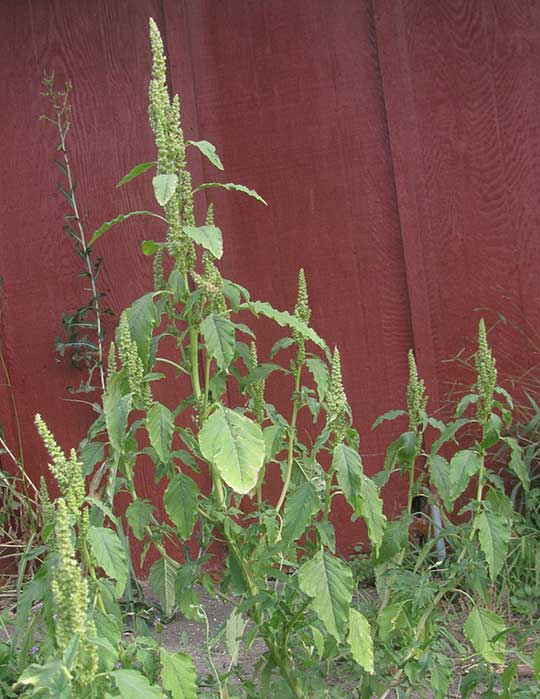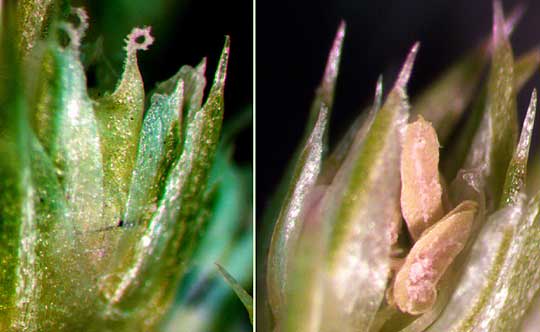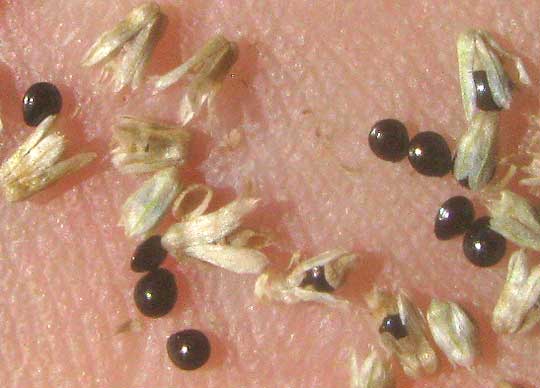Excerpts from Jim Conrad's
Naturalist Newsletter
from the July 7, 2013 Newsletter issued from the Frio Canyon Nature Education Center in the valley of the Dry Frio River in northern Uvalde County, southwestern Texas, on the southern border of the Edwards Plateau; elevation ~1750m (~5750 ft); N29.62°, W99.86°; USA
PIGWEED BESIDE THE CABIN
Most wildflowers and weeds draw attention to themselves with their flowers, but flowers of the leg-tall herb growing next to the red cabin in the valley are so small that even when you look for them it's hard to find them, despite there being thousands and thousands of them. You can see the plant below:

The greenish, crumbly-textured "spikes" atop each of the plant's branches are flowering heads composed of multitudinous flowers about 1/8th inch tall (3mm). The vast majority of the blossoms are female, with only a few male flowers clustered at flowering branch tips. You can see both flower types as observed beneath a dissecting scope below:

In that picture the female flower at the left displays at top, center one of its three white, curving stigmas. Two of three to five pollen-producing anthers dangle outside the male flower at the picture's right. Modified leaves called bracts subtend each flower. In the image of the female flower at the left, that long, sharp-pointed, green thing at the right is a bract. Immediately to the left of that bract arises one of the flower's tepals -- "tepals" being the term used to designate petal-like items serving as both calyx lobes and corolla lobes or petals.
In that image of the female flower, notice that the tepal to the left of the bract bears a tiny, sharp, white spine, or "mucro," at its tip, but just below the mucro the tepal's top expands so that in general shape the tepal is blunt or somewhat squared at the top, even with a couple of "ears" between which the mucro arises. These obscure details are important field marks because they help us distinguish two look-alike, common, widely spread weeds.
Both the weeds are known generally as pigweeds, and they belong to the amaranth genus, Amaranthus. East of the Mississippi mainly I've met with Amaranthus hybridus, but that species' tepals gradually come to a sharp point at their tops, with no ears or mucros. The other species, ours, having those ears and mucro, is AMARANTHUS RETROFLEXUS. In books Amaranthus retroflexus is given many names other than just "pigweed," such as Redroot Pigweed, Redroot Amaranth, Wild-beet Amaranth, Rough Pigweed and Common Amaranth.
Members of the genus Amaranthus are indeed amaranths, the very ones that various cultures worldwide regard highly as leaf vegetables, cereals, and ornamental plants. In Mexico a popular, traditional, sweet, cookie-like item called alegría is made from amaranth seeds toasted until they pop, then glued together with crystallized syrup, and sold in plastic bags. If you shake a section of flowering head from the plant in the picture over the palm of your hand, dozens of tiny, straw-colored fruits collect in your hand. Then if you smush the fruits with your finger, shiny, black seeds pop from their husks, as shown below:

Both of the look-alike pigweeds are native American species who display unusual ecological adaptability, which has enabled them to become weeds worldwide. Most of North America's weeds are Eurasian, so this is one instance when North America is sending weeds to the rest of the world. Our Amaranthus retroflexus is native to central and eastern North America.